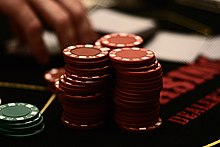| Problem gambling | |
|---|---|
| Other names | Ludophaty, ludomania, degenerate gambling, gambling addiction, compulsive gambling, gambling disorder |
 | |
| Specialty | Psychiatry, clinical psychology |
| Symptoms | Spending a lot of money and time in casino/sports betting, Video game addiction[1] |
| Addiction and dependence glossary[2][3][4] | |
|---|---|
| |
Problem gambling, ludophaty[5] or ludomania is repetitive gambling behavior despite harm and negative consequences. Problem gambling may be diagnosed as a mental disorder according to DSM-5 if certain diagnostic criteria are met. Pathological gambling is a common disorder associated with social and family costs.
The DSM-5 has re-classified the condition as an addictive disorder, with those affected exhibiting many similarities to those with substance addictions. The term gambling addiction has long been used in the recovery movement.[6] Pathological gambling was long considered by the American Psychiatric Association to be an impulse-control disorder rather than an addiction.[7] However, data suggest a closer relationship between pathological gambling and substance use disorders than exists between PG and obsessive–compulsive disorder, mainly because the behaviors in problem gambling and most primary substance use disorders (i.e., those not resulting from a desire to "self-medicate" for another condition such as depression) seek to activate the brain's reward mechanisms while the behaviors characterizing obsessive-compulsive disorder are prompted by overactive and misplaced signals from the brain's fear mechanisms.[8]
Problem gambling is an addictive behavior with a high comorbidity with alcohol problems. A common tendency shared by people who have a gambling addiction is impulsivity.[citation needed]
- ^ David Zendle; Rachel Meyer; Harriet Over (June 2019). "Adolescents and loot boxes: links with problem gambling and motivations for purchase". Royal Society Open Science. 6 (6): 190049. Bibcode:2019RSOS....690049Z. doi:10.1098/rsos.190049. PMC 6599795. PMID 31312481.
- ^ Nestler EJ (December 2013). "Cellular basis of memory for addiction". Dialogues in Clinical Neuroscience. 15 (4): 431–443. PMC 3898681. PMID 24459410.
Despite the importance of numerous psychosocial factors, at its core, drug addiction involves a biological process: the ability of repeated exposure to a drug of abuse to induce changes in a vulnerable brain that drive the compulsive seeking and taking of drugs, and loss of control over drug use, that define a state of addiction. ... A large body of literature has demonstrated that such ΔFosB induction in D1-type [nucleus accumbens] neurons increases an animal's sensitivity to drug as well as natural rewards and promotes drug self-administration, presumably through a process of positive reinforcement ... Another ΔFosB target is cFos: as ΔFosB accumulates with repeated drug exposure it represses c-Fos and contributes to the molecular switch whereby ΔFosB is selectively induced in the chronic drug-treated state.41 ... Moreover, there is increasing evidence that, despite a range of genetic risks for addiction across the population, exposure to sufficiently high doses of a drug for long periods of time can transform someone who has relatively lower genetic loading into an addict.
- ^ Malenka RC, Nestler EJ, Hyman SE (2009). "Chapter 15: Reinforcement and Addictive Disorders". In Sydor A, Brown RY (eds.). Molecular Neuropharmacology: A Foundation for Clinical Neuroscience (2nd ed.). New York: McGraw-Hill Medical. pp. 364–375. ISBN 978-0-07-148127-4.
- ^ Volkow ND, Koob GF, McLellan AT (January 2016). "Neurobiologic Advances from the Brain Disease Model of Addiction". New England Journal of Medicine. 374 (4): 363–371. doi:10.1056/NEJMra1511480. PMC 6135257. PMID 26816013.
Substance-use disorder: A diagnostic term in the fifth edition of the Diagnostic and Statistical Manual of Mental Disorders (DSM-5) referring to recurrent use of alcohol or other drugs that causes clinically and functionally significant impairment, such as health problems, disability, and failure to meet major responsibilities at work, school, or home. Depending on the level of severity, this disorder is classified as mild, moderate, or severe.
Addiction: A term used to indicate the most severe, chronic stage of substance-use disorder, in which there is a substantial loss of self-control, as indicated by compulsive drug taking despite the desire to stop taking the drug. In the DSM-5, the term addiction is synonymous with the classification of severe substance-use disorder. - ^ Zollinger, Manfred (March 31, 2016). Random Riches: Gambling Past & Present. Routledge. p. 34. ISBN 978-1-317-07156-3. Retrieved October 30, 2024.
- ^ Eades, John (2003). Gambling Addiction: The Problem, the Pain, and the Path to Recovery. Vine Books. ISBN 978-0-8307-3425-2.[page needed]
- ^ Petry, Nancy (September 2006). "Should the Scope of Addictive Behaviors be Broadened to Include Pathological Gambling?". Addiction. 101 (s1): 152–60. doi:10.1111/j.1360-0443.2006.01593.x. PMID 16930172.
- ^ Potenza, M. N. (October 12, 2008). "The neurobiology of pathological gambling and drug addiction: an overview and new findings". Philosophical Transactions of the Royal Society B: Biological Sciences. 363 (1507): 3181–3189. doi:10.1098/rstb.2008.0100. PMC 2607329. PMID 18640909.